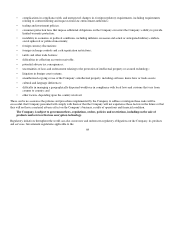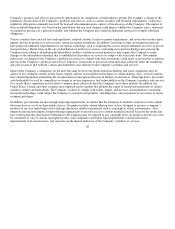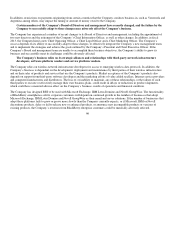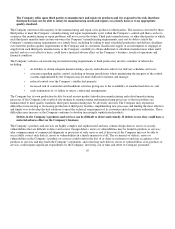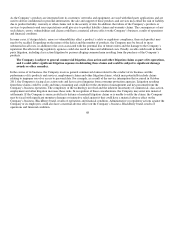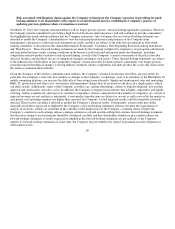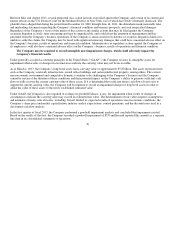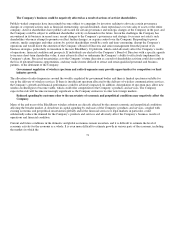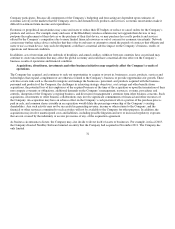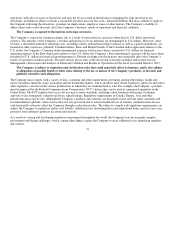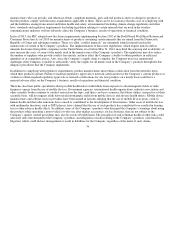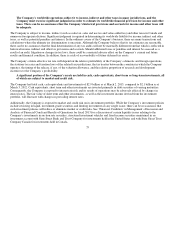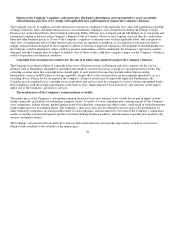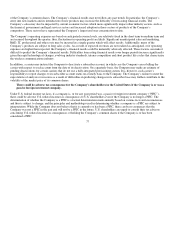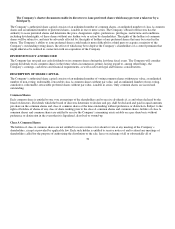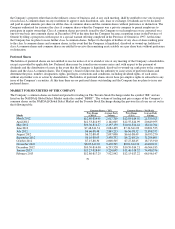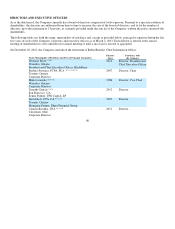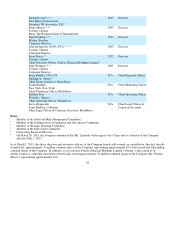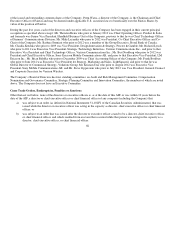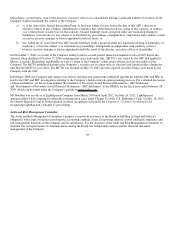Blackberry 2013 Annual Report Download - page 81
Download and view the complete annual report
Please find page 81 of the 2013 Blackberry annual report below. You can navigate through the pages in the report by either clicking on the pages listed below, or by using the keyword search tool below to find specific information within the annual report.
manufacturers who can provide, and otherwise obtain, compliant materials, parts and end products and to re-design its products so
that the products comply with the many requirements applicable to them. There can be no assurance that the costs of complying with
and the liabilities arising from current and future health and safety, environmental (including climate change regulation) and other
laws, standards and regulatory requirements (including legislation relating to certain minerals that are used in the wireless
communications industry) will not adversely affect the Company’s business, results of operations or financial condition.
In fiscal 2013, the SEC adopted new disclosure requirements implementing Section 1502 of the Dodd-Frank Wall Street Reform and
Consumer Protection Act of 2010 for manufacturers of products containing certain minerals that are mined from the Democratic
Republic of Congo and adjoining countries. These so-called “conflict minerals” are commonly found in metals used in the
manufacture of certain of the Company’s products. The implementation of these new regulations, which require initial conflicts
minerals disclosure from public companies in the United States on or before May 31, 2014, may limit the sourcing and availability, or
may increase the costs, of some of the metals used in the manufacture of the Company’s products. The regulations may also reduce
the number of suppliers who provide conflict-free metals, and may affect the Company’s ability to obtain products in sufficient
quantities or at competitive prices. Also, since the Company’s supply chain is complex, the Company may face reputational
challenges if the Company is unable to sufficiently verify the origins for all metals used in the Company’s products through the due
diligence procedures that the Company implements.
In addition to complying with regulatory requirements, product manufacturers must obtain certification from the networks upon
which their products operate. Failure to maintain regulatory approvals or network certifications for the Company’s current products or
a failure to obtain required regulatory approvals or network certifications for any new products on a timely basis could have a
material adverse effect on the Company’s business, results of operations and financial condition.
There has also been public speculation about possible health risks to individuals from exposure to electromagnetic fields or radio
frequency energy from the use of mobile devices. Government agencies, international health organizations, industry associations and
other scientific bodies continue to conduct research on the topic, and there can be no assurance that future studies, irrespective of their
scientific basis, will not suggest a link between electromagnetic fields from mobile devices and adverse health effects. Mobile device
manufacturers and cellular services providers have been named in lawsuits alleging that the use of mobile devices poses a risk to
human health and that radio emissions have caused or contributed to the development of brain tumors. Other users of mobile devices
with multimedia functions, such as MP3 players, have claimed that the use of such products has contributed to or resulted in hearing
loss or other adverse health effects. In addition, users of the Company’s products who disregard the Company’s warnings about using
the products while operating a motor vehicle or who use after-market accessories, such as batteries, that are not subject to the
Company’s quality control procedures may also be at risk of bodily harm. The perception of risk to human health or other risks could
adversely affect the demand for the Company’s products and allegations of risks relating to the Company’s products could result in
litigation, which could distract management or result in liabilities for the Company, regardless of the merit of such claims.
74


